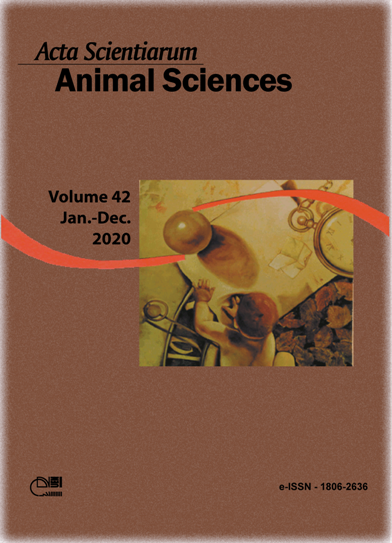Nutrient fluxes and environmental performance indicators for a pasture-based dairy system
Resumo
The aim of this study was to evaluate the nutrient fluxes for lactating cows in a pasture-based dairy system and the impact of a nutritional management strategy on the environmental performance indicators. Fourteen lactating cows were divided into two experimental groups with seven animals each. The nutritional managements were a diet containing 20% crude protein (Group 1) and a diet with adjusted protein (Group 2). The nutrient budget was calculated on a monthly basis for nitrogen, phosphorus, and potassium. The nutritional strategy of adjusted protein reduces the total surplus in the lactation period for nitrogen by 7.6% and for phosphorus by 6.3%. The total potassium surplus of the adjusted protein group was 8.5% higher. The average nitrogen use efficiency was 21% for group 1 and 22.7% for group 2. Phosphorus use efficiency ranged from 13.4 to 35% for group 1 and from 15.5 to 34% for group 2 and potassium average use efficiency was 14.2% for group 1 and 12.6% for group 2. Nutritional management reduced nitrogen and phosphorus surpluses as well as the values of the environmental performance indicator. Based on this, it is possible to improve the environmental efficiency of dairy systems through improved nutritional management.
Downloads
Referências
Aarons, S. R., Cameron, J. P., Gourley, J., Powell, M., & Hannah, M. C. (2017). Estimating nitrogen excretion and deposition by lactating cows in grazed dairy systems. Soil Research, 55, 489–499. doi: 10.1071/SR17033
Agricultural Research Council [ARC]. (1994). The Nutrient Requirements of Ruminant Livestock. Wallingford, OX: CAB.
Burchill, W., Lanigan, G. J., Li, D., Williams, M., & Humphreys, J. (2016). A system N balance for a pasture-based system of dairy production under moist maritime climatic conditions. Agriculture, Ecosystems & Environment, 220(15), 202-210. doi: 10.1016/j.agee.2015.12.022
Einarsson, R., Cederberg, C., & Kallus, J. (2017). Nitrogen flows on organic and conventional dairy farms: a comparison of three indicators. Nutrient Cycling Agroecosystem, 110, 25-38. doi: 10.1007/s10705-017-9861-y
Godinot, O., Carof, M., Vertès, F., & Leterme, P. (2014). SyE: an improved indicator to assess nitrogen efficiency of farming systems. Agricultural Systems, 127, 41–52. doi: 10.1016/j.agsy.2014.01.003
Gourley, C. J. P., Dougherty, W., Weaver, D. M., Aarons, S. R., Awty, I. M., Gibson, D. M., … Peverill, K. I. (2012). Farm-scale nitrogen, phosphorus, potassium and sulphur balances and use efficiencies on Australian dairy farms. Animal Production Science, 52, 929–944. doi: 10.1071/AN11337
Jan, P., Calabrese, C., & Lips, M. (2017). Determinants of nitrogen surplus at farm level in Swiss agriculture. Nutrient Cycling Agroecosystem, 109, 133–148. doi: 10.1007/s10705-017-9871-9
Mihailescu, E., Murphy, P. N. C., Ryan, W., Casey, I. A., & Humphreys, I. (2015). Phosphorus balance and use efficiency on 21 intensive grass-based dairy farms in the South of Ireland. Journal of Agricultural Science, 153(3), 520–537. doi:10.1017/S0021859614000641
Mu, W., Van Middelaar, C. E., Bloemhof, J. M., Oenema, J., & Boer, I. J. M. (2016). Nutrient balance at chain level: a valuable approach to benchmark nutrient losses of milk production systems. Journal Cleaner Production, 112(4), 2419–2428. doi: 10.1016/j.jclepro.2015.09.116
Nevens, F., Verbruggen, I., Reheul, D., & Hofman, G. (2006). Farm gate nitrogen surpluses and nitrogen use efficiency of specialized dairy farms in Flanders: evolution and future goals. Agricultural Systems, 88(2-3), 142–155. doi:10.1016/j.agsy.2005.03.005
Oenema, J., Van Ittersum, M., & Van Keulen, H. (2012). Improving nitrogen management on grassland on commercial pilot dairy farms in the Netherlands. Agriculture, Ecosystems and Environment, 162, 116–126. doi: 10.1016/j.agee.2012.08.012
Powell, J. M., Barros, T., Danes, M., Aguerred, M., Wattiaux, M., & Reed, K. (2017). Nitrogen use efficiencies to grow, feed, and recycle manure from the major diet components fed to dairy cows in the USA. Agriculture, Ecosystems and Environment, 239, 274–282. doi: 10.1016/j.agee.2017.01.023
Ruiz, T. M., Sotomayor-Ramírez, D., Torres-Meléndez, C., & Martínez-Rodriguez, G. A. (2016). Phosphorus mass cycling and balance in dairy farms: Case studies in Puerto Rico. Agriculture, Ecosystems and Environment, 220, 115–124. doi; 10.1016/j.agee.2016.01.003
Sotomayor-Ramírez, D., Ruiz, T., & Martínez, G (2003). Phosphorus balance on dairy farms of Puerto Rico. The Journal of Agriculture of the University of Puerto Rico, 87(1-2), 59-64.
Stott, K. J., & Gourley, C. J. P. (2016). Intensification, nitrogen use and recovery in grazing-based dairy systems. Agricultural Systems, 144, 101–112. doi: 10.1016/j.agsy.2016.01.003
Valadares Filho, S. C., Machado, P. A. S., Chizzotti, M. L., Amaral, H. F., Magalhães, K. A., & Rocha Junior, V. R. (2011). CQBAL 3.0. Tabelas Brasileiras de Composição de Alimentos para Bovinos. Viçosa, MG: UFV.
White, R. R. (2016). Increasing energy and protein use efficiency improves opportunities to decrease land use, water use, and greenhouse gas emissions from dairy production. Agricultural Systems, 146, 20–29. doi: 10.1016/j.agsy.2016.03.013
Wood, S. A., Smith, M. R., Fanzo, J., Remans, R., & DeFries, R. S. (2018). Trade and the equitability of global food nutrient distribution. Nature Sustainability, 1(1), 34–37. doi: 10.1038/s41893-017-0008-6
DECLARAÇÃO DE ORIGINALIDADE E DIREITOS AUTORAIS
Declaro que o presente artigo é original, não tendo sido submetido à publicação em qualquer outro periódico nacional ou internacional, quer seja em parte ou em sua totalidade.
Os direitos autorais pertencem exclusivamente aos autores. Os direitos de licenciamento utilizados pelo periódico é a licença Creative Commons Attribution 4.0 (CC BY 4.0): são permitidos o compartilhamento (cópia e distribuição do material em qualqer meio ou formato) e adaptação (remix, transformação e criação de material a partir do conteúdo assim licenciado para quaisquer fins, inclusive comerciais.
Recomenda-se a leitura desse link para maiores informações sobre o tema: fornecimento de créditos e referências de forma correta, entre outros detalhes cruciais para uso adequado do material licenciado.








































